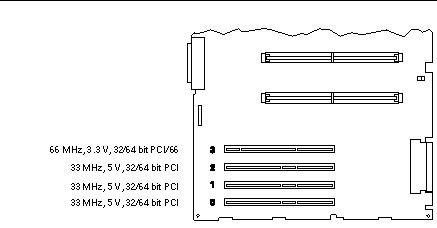About Peripheral Component Interconnect (PCI) Buses
All system communication with storage peripherals and network interface devices is mediated by a UPA-to-PCI bridge, located on the system's main logic board. This bridge chip manages communication between the UPA bus and the system's two PCI buses. These PCI buses support slots for up to four PCI interface cards. One PCI bus (bus 0) also handles communication between the system and devices connected to the main logic board's SCSI, FastEthernet, serial, parallel, and keyboard/mouse ports.
PCI cards come in a variety of configurations. Not all cards will fit or operate in all PCI slots, so it is important to know the specifications of your PCI cards and the types of cards supported by each PCI slot in the system.
Some PCI cards are as short as 6.875 inches (17.46 cm) in length (called "short" cards), while the maximum length of PCI cards is 12.28 inches (31.19 cm, called "long" cards). Each slot in the system can accommodate either a long or a short card.
Older PCI cards communicate over 32-bit PCI buses, while many newer cards communicate over wider 64-bit buses. All four PCI slots will accept either 32-bit or 64-bit wide cards.
Older PCI cards operate at 5 VDC, while newer cards are designed to operate on 3.3 VDC. Cards that require 5 volts will not operate in 3.3-volt slots, and 3.3-volt cards will not operate in 5-volt slots. "Universal" PCI cards are designed to operate on either 3.3 volts or 5 volts, so these cards can be inserted into either type of slot. The system provides three slots for 5-volt cards and one slot for a 3.3-volt card. All four PCI slots accept universal cards.
Most PCI cards operate at clock speeds of 33 MHz, while some newer cards operate at 66 MHz. All four PCI slots can accept 33-MHz cards. 66-MHz cards are restricted to the slot labelled PCI66-0.
The table below shows the mapping of the PCI slots to the two PCI buses, and the type of PCI cards supported in each slot.
Table 5-1|
Rear Panel Slot Number |
Connector Label |
PCI Bus |
Slot Width (bits)/ Card Type (bits) |
Clock Rates (MHz) |
DC Voltage/ Card Type |
|---|---|---|---|---|---|
|
3 |
PCI66-0 |
1 |
64 / 32 or 64 |
33 and 66 |
3.3 V & Univ |
|
2 |
PCI33-2 |
0 |
64 / 32 or 64 |
33 |
5 V & Univ |
|
1 |
PCI33-1 |
0 |
64 / 32 or 64 |
33 |
5 V & Univ |
|
0 |
PCI33-0 |
0 |
64 / 32 or 64 |
33 |
5 V & Univ |
The following figure shows the PCI slots on the main logic board.
Figure 5-5

Configuration Rules
All slots support PCI universal cards.
All slots support PCI long or short cards.
Each slot can supply up to 16 watts of power. The total power used for all four slots must not exceed 64 watts.
PCI cards may be freely installed in any compatible PCI slots. Slots need not be filled in any particular order. In most cases, the system's I/O performance will be unaffected by placement of PCI cards in the slots. Heavily loaded systems, however, will deliver better overall performance by installing high-throughput interface cards on separate buses. Examples of high-throughput interfaces are dual-channel UltraSCSI host adapters and ATM-622 interfaces.
Overall system availability may also be improved by installing redundant storage or network interfaces on separate PCI buses.
- © 2010, Oracle Corporation and/or its affiliates
